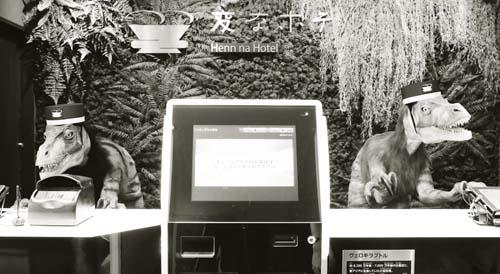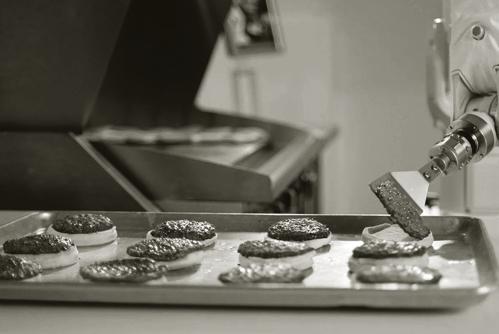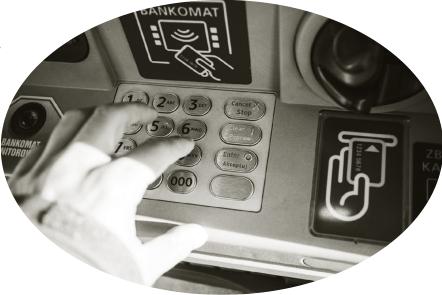机器人将彻底改变快餐业
2018-08-06ByAlanaSemuels
By Alana Semuels
Visitors to Henn-na, a restaurant outside Nagasaki, Japan, are greeted by a peculiar sight: their food being prepared by a row of humanoid robots that bear a passing1 resemblance to the Terminator. The “head chef,”incongruously2 named Andrew, specializes in okonomiyaki, a Japanese pancake. Using his two long arms, he stirs batter in a metal bowl, then pours it onto a hot grill. While he waits for the batter to cook, he talks cheerily in Japanese about how much he enjoys his job. His robot colleagues, meanwhile, fry donuts, layer soft-serve ice cream into cones, and mix drinks.

H.I.S., the company that runs the restaurant, as well as a nearby hotel where robots check guests into their rooms and help with their luggage, turned to automation partly out of necessity. Japans population is shrinking, and its economy is booming; the unemployment rate is currently an unprecedented 2.8 percent. “Using robots makes a lot of sense in a country like Japan, where its hard to find employees,”CEO Hideo Sawada said.
Sawada speculates that 70 percent of the jobs at Japans hotels will be automated in the next five years.“It takes about a year to two years to get your money back,” he said. “But since you can work them 24 hours a day, and they dont need vacation, eventually its more cost-efficient to use the robot.”
This may seem like a vision of the future best suited—perhaps only suited—to Japan. But according to Michael Chui, a partner at the McKinsey Global Institute, many tasks in the food-service and accommodation industry are exactly the kind that are easily automated. Chuis latest research estimates that 54 percent of the tasks workers perform in American restaurants and hotels could be automated using currently available technologies—making it the fourthmost-automatable sector in the U.S.


The robots, in fact, are already here. Chowbotics, a company in Redwood City, California, manufactures Sally, a boxy robot that prepares salads ordered on a touch screen. At a Palo Alto café, I watched as she deposited lettuce, corn, barley, and a few inadvertently3 crushed cherry tomatoes into a bowl. Botlr, a robot butler, now brings guests extra towels and toiletries in dozens of hotels around the country.4
One robot, Flippy, can flip5 150 burgers an hour. Ostensibly6, this is worrying. Americas economy isnt humming along nearly as smoothly as Japans, and one of the few bright spots in recent years has been employment in restaurants and hotels, which have added more jobs than almost any other sector. That growth, in fact, has helped dull the blow that automation has delivered to other industries. The food-service and accommodation sector now employs 13.7 million Americans, up 38 percent since 2000. Since 2013, it has accounted for more jobs than manufacturing.
These new positions once seemed safe from the robot hordes7 because they required a human touch in a way that manufacturing or mining jobs did not. When ordering a coffee or checking into a hotel, human beings want to interact with other human beings—or so we thought. The companies bringing robots into the service sector are betting that well be happy to trade our relationship with the chipper8 barista or knowledgeable front-desk clerk for greater efficiency. Theyre also confident that adding robots wont necessarily mean cutting human jobs.
Robots have arrived in American restaurants and hotels for the same reasons they first arrived on factory floors. The cost of machines, even sophisticated ones, has fallen significantly in recent years, dropping 40 percent since 2005, according to the Boston Consulting Group. Labor, meanwhile, is getting expensive, as some cities and states pass laws raising the minimum wage.
Wendys, McDonalds, and Panera are in the process of installing self-service kiosks9 in locations across the country, allowing customers to order without ever talking to an employee. Starbucks encourages customers to order on its mobile app; such transactions now account for 10 percent of sales. The early success of the kiosks suggests that, at least when ordering fast food, patrons prize speed over high-touch customer service.
Technology obviates10 old jobs, but it also creates new ones. At Zume Pizza, in Mountain View, California, I watched an assembly line of robots spread sauce on dough and lift pies into the oven. Thanks to its early investment in automation, Zume spends only 10 percent of its budget on labor, compared with 25 percent at a typical restaurant operation. The humans it does employ are given above-average wages and perks11. Zume also offers tuition reimbursement12 and tutoring in coding and data science. Freedom Carlson, who started in the kitchen where she toiled alongside the robots, has been promoted to culinary-program administrator, and is learning to navigate the software that calculates nutritional facts for Zume pizzas.
However, transitioning to a new type of work is never easy, and it might be particularly difficult for many in the service sector. New jobs that arise after a technological upheaval13 tend to require skills that laid-off workers dont have. A college education helps insulate14 workers from automation, enabling them to develop the kind of expertise, judgment, and problem-solving abilities that robots cant match. Yet nearly 80 percent of workers in food preparation and service-related occupations have a high-school diploma or less, according to the Bureau of Labor Statistics.
The better hope for workers might be that automation helps the food-service and accommodation sector continue to thrive. Paneras Hurst told me that because of its new kiosks, and an app that allows online ordering, the chain is now processing more orders overall, which means it needs more total workers to fulfill customer demand. Starbucks patrons who use the chains app return more frequently than those who dont, the company has said, and the greater efficiency that online ordering allows has boosted sales at busy stores during peak hours. Starbucks employed eight percent more people in the U.S. in 2016 than it did in 2015, the year it launched the app.
Of course, whether automation is a net positive for workers in restaurants and hotels, and not just a competitive advantage for one chain over another, will depend on whether an improved customer experience makes Americans more likely to dine out and stay at hotels, rather than brownbagging15 it or finding an Airbnb.
That could be the case. James Bessen, an economist at Boston University School of Law, found that as the number of ATMs in America increased fivefold from 1990 to 2010, the number of bank tellers also grew. Bessen believes that ATMs drove demand for consumer banking: No longer constrained by a branchs limited hours, consumers used banking services more frequently, and people who were unbanked opened accounts to take advantage of the new technology. Although each branch employed fewer tellers, banks added more branches, so the number of tellers grew overall.
And as machines took over many basic cashhandling tasks, the nature of the tellers job changed. They were now tasked with talking to customers about products—a certificate of deposit, an auto loan—which in turn made them more valuable to their employers. Therefore, as Bessen said, “Its still not clear that automation in the restaurant industry will lead to job losses.”

在日本长崎县外一家名为Henn-na的餐厅里,游客们看到了一种奇特的景象:一排人形机器人在为顾客准备食物,这种景象与《终结者》中的情节有点儿相似。机器人“主厨”名叫安德鲁,这个名字显得不那么适合;他擅长制作大阪烧(一种日式煎饼)。只见他挥起两条长长的手臂,在一个金属碗里搅拌面粉,再将面粉倒在一个炙热的烤架上。在等待面糊烤熟之时,他用日语开心地说着他有多喜欢自己的工作。与此同时,他的机器人同事们在炸甜甜圈、把软冰淇淋层层挤进甜筒里以及调制饮料。
这家餐厅由H.I.S.公司负责经营,公司旗下还有一家位于附近的酒店,也由机器人为客人办理住宿,并帮助他们搬运行李。H.I.S.公司这种自动化发展趋势在一定程度上是出于所需。日本的人口正在不断减少,但经济正在蓬勃发展;目前,日本的失业率已降低到史无前例的2.8%。“在日本这样的国家,使用机器人有非常重要的意义,因为在这里,员工非常匮乏。”首席执行官泽田秀雄(Hideo Sawada)说。
泽田秀雄推测,在未来五年内,日本酒店中70%的工作将实现自动化。“只需要一到两年的时间,就可以收回成本。”他说道,“但由于机器人可以一天工作24小时,而且不需要休假,因此最终看来,使用机器人会更加合算。”
这看起来像是最适合——或许是只适合——日本未来的一种设想。但麦肯锡全球研究院合伙人迈克爾·崔表示,餐饮服务以及酒店行业的许多任务都很容易实现自动化。迈克尔·崔在最近的研究中预测,在美国的餐厅和酒店里,工人们54%的操作都可以通过现有技术实现自动化,因而使其成为美国第四大可自动化行业。
事实上,机器人在美国早已被应用。加州雷德伍德城有一家名为Chowbotics的公司,其生产的就是一款名为Sally的四方形机器人,她可以为通过触屏设备下单的用户制作沙拉。在帕洛阿尔托(美国旧金山附近城市)的一家咖啡馆里,我亲眼目睹她把莴苣、玉米、大麦和些许不慎捣碎的圣女果丁放进碗里。现在,美国几十家酒店都应用了一款名叫Botlr的机器人管家,其工作主要是为客人增添毛巾以及洗漱用具。
还有一款名叫Flippy的机器人,每小时可以制作150个汉堡。从表面上看,这不禁令人担忧。美国经济的发展并不像日本那样一路高歌,其中,近年来为数不多的亮点之一就是餐厅和酒店为人们增加了就业机会,而且增加的数量比其他任何行业都要多。事实上,这一增长缓解了自动化对于其他行业的冲击。餐饮和酒店两大行业如今能够解决1,370万美国人的就业,与2000年相比增加了38%。自2013年以来,与制造业相比,它创造了更多的就业岗位。
在过去,这些新岗位似乎并不会受到机器人大军的威胁,因为它需要人与人的接触,而这在制造业或采矿业中却不是必须的。当点咖啡或入住酒店时,人们需要与他人进行互动——或者我们认为应是如此。将机器人引入服务行业的公司则认为,我们会愿意牺牲与精力充沛的咖啡师和见多识广的前台所建立的那些人际关系,从而换取更高的效率。他们也相信,增加机器人并不一定意味着人类工作岗位的减少。
机器人已经出现在美国的餐厅和酒店之中,原因与他们首次进入工厂车间时一样。据波士顿咨询集团称,近年来,机器的成本大幅下降(即便是那些复杂精密的机器),自2005年以来已经下降了40%。与此同时,由于一些城市和州通过了提高最低工资的法律条款,劳动力成本正在逐渐上升。
温迪国际快餐连锁集团(Wendys)、麦当劳以及美国面包连锁品牌Panera正在全国各地安装自助贩卖亭,可以让顾客在点餐时甚至都不用与员工交谈。星巴克鼓励顾客使用移动应用下单;现在,通过这种方式进行的交易占销售总额的10%。这些自助贩卖亭早期所取得的成功表明,至少在订购快餐的时候,相比高接触服务,顾客更看重的是速度。
科技淘汰了旧的工作岗位,但也创造了新的工作。在美国加州山景城的Zume披萨店,我看到了机器人的流水作业,他们在面团上撒上酱汁,再把馅饼放到烤箱里。Zume得益于其在自动化方面的早期投资,劳动力成本只占预算支出的10%,而对于一个普通的餐厅,这一比例则为25%。Zume给雇佣工人的工资和福利都高于行业的平均水平;此外,Zume还为员工提供编码和数据科学方面的学费补助及辅导。弗里德姆·卡尔森原是厨房的一名工作人员,在那里,她与机器人一起辛勤工作,如今,她已经被提升为“厨房项目管理员”,并且正在学习使用为Zume披萨计算营养成分的软件。
然而,过渡到一种新型的工作并不是那么容易,而且对于从事服务行业的许多人来说,这可能尤其困难。技术变革后出现的新工作所需要的技能往往是下岗工人所不具备的。大学教育能够帮助工人免受自动化的影响,培养他们的专业知识、判断力以及解决问题的能力,而这正是机器人所无法比拟的。然而,根据美国劳工统计局的数据统计,在配制食物以及相关的服务行业中,近80%的工人仅拥有高中或以下的学历。
对于工人们来说,寄希望于自动化以推动餐饮服务及酒店行业的持续繁荣发展,可能是他们更好的选择。在Panera工作的赫斯特告诉我,凭借新增添的自助贩卖亭以及在线订购应用,其连锁店现在能够处理更多的订单,这就意味着他们需要增加员工以满足客户的需求。星巴克公司表示,使用应用程序下单的顾客,回头率要比通过传统方式购买的顾客高,而在线订购所带来的更高效率也极大地提高了高峰时段忙碌的店面内的销售额。自2015年推出应用程序之后,星巴克2016年在美国的员工数量比前一年高出了8%。
当然,对于餐厅和酒店的员工来说,自动化能否实现净利润,而不仅仅是连锁企业之间竞争的优势所在,将取决于一点,那就是优化的客户体验是否会让美国人更愿意外出就餐并下榻酒店,而不是选择自备午餐或是在爱彼迎(美国短租平台)上找一家住宿。
情况可能就是如此。波士顿大学法学院经济学家詹姆斯·贝森发现,1990年至2010年间,美国自动取款机的数量增加了五倍,而银行出纳员的数量也在增加。贝森认为,自动取款机拉动了消费者对银行业务的需求:不再受银行网点工作时间的限制,消费者使用银行服务的频率增加了,而没有银行账户的人则利用新技术开设了账户。尽管每个网点的出纳员数量都有所减少,但银行开设了更多的分行,因此出纳员的数量总体上反而增加了。
而且,由于机器能够承担更多基本的现金处理任务,出纳员的工作性质就发生了变化。他们现在的任务是为客户讲解产品——比如一份存款证明,或者一个汽车贷款——而这反过来又使他们对于雇主的价值有所提升。因此,正如贝森所说,“目前还不清楚餐饮行业的自动化是否会导致失业。”
1. passing: 轻微的。
2. incongruously: // 不适当地,不相称地。
3. inadvertently: 非故意地,无心地。
4. butler: 男管家;toiletries: 梳妆用品。
5. flip: 在快餐店制作食物(如汉堡包)。
6. ostensibly: 表面地,假装地。
7. horde: 一大群。
8. chipper: 活泼的,精力充沛的。
9. kiosk: 小亭,售货亭。
10. obviate: 排除,消除。
11. perk: 特殊待遇。
12. reimbursement: 退还,赔偿。
13. upheaval: 剧变,动乱。
14. insulate: 使隔绝,使免受影响(常与from, against连用)。
15. brown-bagging: 自备午餐,自带瓶酒上餐厅。
